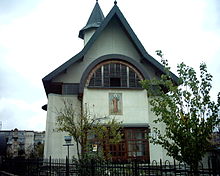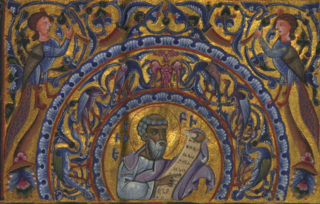
Eusebius of Caesarea, also known as Eusebius Pamphilus, was a Greek historian of Christianity, exegete, and Christian polemicist. In about AD 314 he became the bishop of Caesarea Maritima in the Roman province of Syria Palaestina. Together with Pamphilus, he was a scholar of the biblical canon and is regarded as one of the most learned Christians during late antiquity. He wrote Demonstrations of the Gospel, Preparations for the Gospel and On Discrepancies between the Gospels, studies of the biblical text. As "Father of Church History", he produced the Ecclesiastical History, On the Life of Pamphilus, the Chronicle and On the Martyrs. He also produced a biographical work on Constantine the Great, the first Christian Roman emperor, who was augustus between AD 306 and AD 337.

Origen of Alexandria, also known as Origen Adamantius, was an early Christian scholar, ascetic, and theologian who was born and spent the first half of his career in Alexandria. He was a prolific writer who wrote roughly 2,000 treatises in multiple branches of theology, including textual criticism, biblical exegesis and hermeneutics, homiletics, and spirituality. He was one of the most influential and controversial figures in early Christian theology, apologetics, and asceticism. He has been described as "the greatest genius the early church ever produced".
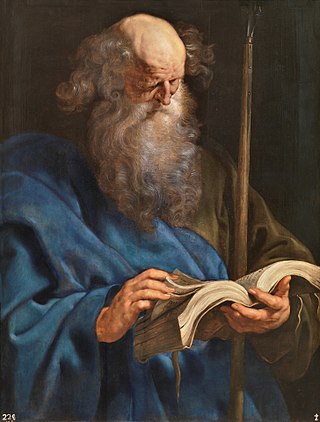
Thomas the Apostle, also known as Didymus, was one of the Twelve Apostles of Jesus according to the New Testament. Thomas is commonly known as "Doubting Thomas" because he initially doubted the resurrection of Jesus Christ when he was told of it ; he later confessed his faith on seeing the wounds left over from the crucifixion.
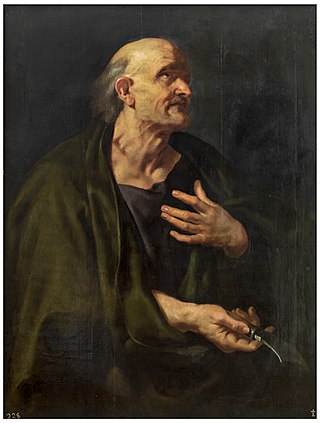
Bartholomew was one of the twelve apostles of Jesus according to the New Testament. Some identify Bartholomew as Nathanael or Nathaniel, who appears in the Gospel of John, although this is not supported by the Gospels, Acts, or any early, reliable Christian tradition.
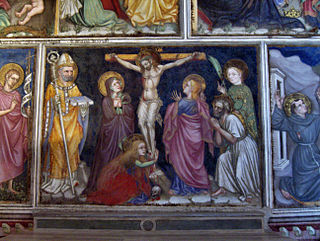
Jacobus de Voragine was an Italian chronicler and archbishop of Genoa. He was the author, or more accurately the compiler, of the Golden Legend, a collection of the legendary lives of the greater saints of the medieval church that was one of the most popular religious works of the Middle Ages.

Stachys the Apostle was the second bishop of Byzantium, from AD 38 to AD 54. He seemed to be closely connected to Andrew and Paul. Eusebius quotes Origen as saying that Andrew had preached in Asia Minor and in Scythia, along the Black Sea as far as the Volga and Kiev, hence he became a patron saint of Romania and Russia. According to tradition, Saint Andrew founded the See of Byzantium in 38, installing Stachys as bishop. This See would later develop into the Patriarchate of Constantinople, having Apostle Andrew as its Patron Saint. It was not clear if Stachys was the same person whom Paul calls "dear" in the Epistle to the Romans, but anyway, he is always associated in traditions with five other apostles that are the very same names mentioned together with him by Paul in Romans 16:8-11.

James the Less is a figure of early Christianity, one of the Twelve chosen by Jesus. He is also called "the Minor", "the Little", "the Lesser", or "the Younger", according to translation. He is not to be confused with James the Great. He is identified by some as James, son of Alphaeus and as James, brother of Jesus, thought of by Jerome and others as really the cousin of Jesus. James the Less has traditionally been commemorated along with St. Philip in the Western Christian calendars. In the Roman Catholic Church their feast day was observed on May 1 until 1955, when it was moved to May 11 to accommodate the Feast of St Joseph the Worker on May 1. A later revision of the calendar moved the feast back to May 3. In many other churches the feast has never moved from May 1.

James the Just, or a variation of James, brother of the Lord, was "a brother of Jesus", according to the New Testament. He was an early leader of the Jerusalem Church of the Apostolic Age. Traditionally, it is believed he was martyred in AD 62 or 69 by being stoned to death by the Pharisees on order of High Priest Ananus ben Ananus.

Simon the Zealot or Simon the Canaanite or Simon the Canaanean was one of the most obscure among the apostles of Jesus. A few pseudepigraphical writings were connected to him, but Saint Jerome does not include him in De viris illustribus written between 392 and 393 AD.
An apostolic see is an episcopal see whose foundation is attributed to one or more of the apostles of Jesus or to one of their close associates. In Catholicism the phrase, preceded by the definite article and usually capitalized, refers to the See of Rome.
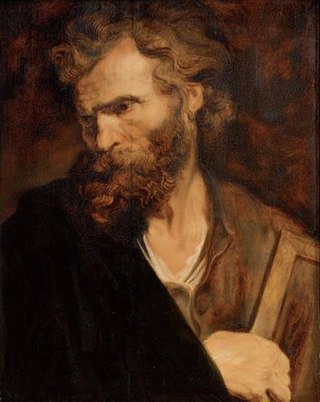
Jude was one of the Twelve Apostles of Jesus according to the New Testament. He is generally identified as Thaddeus, and is also variously called Judas Thaddaeus, Jude Thaddaeus, Jude of James, or Lebbaeus and is considered as the founding father and the first Catholicos-Patriarch of the Armenian Apostolic Church. He is sometimes identified with Jude, the brother of Jesus, but is clearly distinguished from Judas Iscariot, the apostle who betrayed Jesus prior to his crucifixion. Catholic writer Michal Hunt suggests that Judas Thaddaeus became known as Jude after early translators of the New Testament from Greek into English sought to distinguish him from Judas Iscariot and subsequently abbreviated his forename. Most versions of the New Testament in languages other than English and French refer to Judas and Jude by the same name.

According to Eastern Christian tradition, Addai of Edessa or Thaddeus of Edessa was one of the seventy disciples of Jesus. He is possibly identical with Thaddaeus, one of the Twelve Apostles. From an early date his hagiography is filled with legends and fabrications. The saint himself may be entirely fictitious.
Saint Pamphilus, was a presbyter of Caesarea and chief among the biblical scholars of his generation. He was the friend and teacher of Eusebius of Caesarea, who recorded details of his career in a three-book Vita that has been lost.
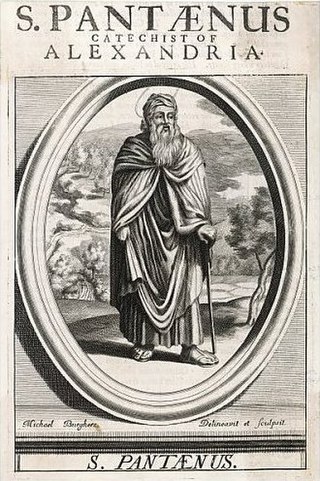
Saint Pantaenus the Philosopher was a Greek theologian and a significant figure in the Catechetical School of Alexandria from around AD 180. This school was the earliest catechetical school, and became influential in the development of Christian theology.

Alexander of Jerusalem was a third century bishop who is venerated as a martyr and saint by the Eastern Orthodox Church, Oriental Orthodox churches, and the Roman Catholic Church. He died during the persecution of Emperor Decius.
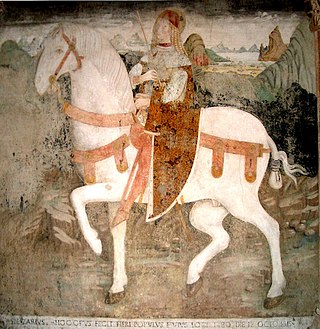
Nazarius and Celsus (Italian: San Nazaro e San Celso; German: Nazarius were two martyrs of whom little is known beyond the discovery of their bodies by Ambrose of Milan.
Basilides and Potamiaena were Christian martyrs now venerated as saints. Both died in Alexandria during the persecutions under Septimius Severus.
The Christian Gospels of Mark and Matthew say that, after the Ascension of Jesus, his Apostles "went out and preached everywhere". This is described in Mark 16 verses 19 and 20, and Matthew 28 verses 19 and 20. According to a tradition mentioned by Eusebius, they dispersed to distinct parts of the world. In the Middle Ages a liturgical feast of the Dispersion of the Apostles was celebrated to commemorate their missionary work and their founding the apostolic sees. This annual feast was held on 15 July and ranked as a major double.
Early Christianity, up to the First Council of Nicaea in 325, spread from the Levant, across the Roman Empire, and beyond. Originally, this progression was closely connected to already established Jewish centers in the Holy Land and the Jewish diaspora. The first followers of Christianity were Jews who had converted to the faith, i.e. Jewish Christians.

Andrew the Apostle, also called Saint Andrew, was an apostle of Jesus according to the New Testament. He is the brother of Simon Peter and is a son of Jonah. He is referred to in the Orthodox tradition as the First-Called.
